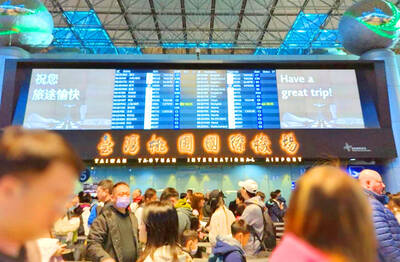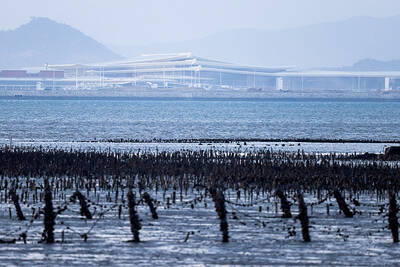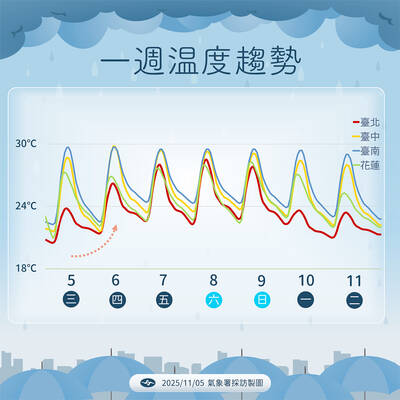Kinmen’s Mofan Street (模範街) has become a new sightseeing spot for tourists from across the Strait after it was decorated with a sea of flags of both the Republic of China (ROC) and the People’s Republic of China (PRC).
Local residents might fly the national flag during Double Ten National Day, but during the New Year holiday the street, which was built in 1924, was lined with national flags on one side and Chinese flags on the other. Many visitors were seen taking pictures and sharing them on social media.
Two Chinese visitors from Xiamen in China’s Fujian Province said it felt good to see their country’s familiar five-star flags.

Photo: Wu Cheng-ting, Taipei Times
The two flags facing one another on the street “symbolize that the two sides of the Strait can coexist and prosper together,” a Taiwanese surnamed Lee (李) said.
Some tourists have compared the street with Panmunjom — the joint security village located between South Korea and North Korea where the 1953 Korean Armistice Agreement that ended fighting in the Korean War was signed.
While many residents said they did not know who first put up the Chinese flags, Dongmen Borough (東門里) Warden Tsai Hsiang-kun (蔡祥坤) said the idea was broached by local ceramic artist Wang Ming-tsung (王明宗).
The motive was quite simple at the onset, Tsai said: to boost local economic activity.
Hanging two flags side by side is a form of installation art and a creative idea, Wang said, adding that more Chinese than Taiwanese visit Kinmen nowadays.
The question of whether the flags are symbolic of “one nation on each side [of the Taiwan Strait]” or “one country, two systems” (一國兩制) is on many visitors’ minds, Wang said.
Wang and Tsai said they were delighted to see the street invigorated by tourists and the flags would remain there until the Lunar New Year in February.
However, they called on visitors not to drive cars into the street.

Three Taiwanese airlines have prohibited passengers from packing Bluetooth earbuds and their charger cases in checked luggage. EVA Air and Uni Air said that Bluetooth earbuds and charger cases are categorized as portable electronic devices, which should be switched off if they are placed in checked luggage based on international aviation safety regulations. They must not be in standby or sleep mode. However, as charging would continue when earbuds are placed in the charger cases, which would contravene international aviation regulations, their cases must be carried as hand luggage, they said. Tigerair Taiwan said that earbud charger cases are equipped

Foreign travelers entering Taiwan on a short layover via Taiwan Taoyuan International Airport are receiving NT$600 gift vouchers from yesterday, the Tourism Administration said, adding that it hopes the incentive would boost tourism consumption at the airport. The program, which allows travelers holding non-Taiwan passports who enter the country during a layover of up to 24 hours to claim a voucher, aims to promote attractions at the airport, the agency said in a statement on Friday. To participate, travelers must sign up on the campaign Web site, the agency said. They can then present their passport and boarding pass for their connecting international

UNILATERAL MOVES: Officials have raised concerns that Beijing could try to exert economic control over Kinmen in a key development plan next year The Civil Aviation Administration (CAA) yesterday said that China has so far failed to provide any information about a new airport expected to open next year that is less than 10km from a Taiwanese airport, raising flight safety concerns. Xiamen Xiangan International Airport is only about 3km at its closest point from the islands in Kinmen County — the scene of on-off fighting during the Cold War — and construction work can be seen and heard clearly from the Taiwan side. In a written statement sent to Reuters, the CAA said that airports close to each other need detailed advanced

UNKNOWN TRAJECTORY: The storm could move in four possible directions, with the fourth option considered the most threatening to Taiwan, meteorologist Lin De-en said A soon-to-be-formed tropical storm east of the Philippines could begin affecting Taiwan on Wednesday next week, the Central Weather Administration (CWA) said yesterday. The storm, to be named Fung-wong (鳳凰), is forecast to approach Taiwan on Tuesday next week and could begin affecting the weather in Taiwan on Wednesday, CWA forecaster Huang En-hung (黃恩鴻) said, adding that its impact might be amplified by the combined effect with the northeast monsoon. As of 2pm yesterday, the system’s center was 2,800km southeast of Oluanbi (鵝鑾鼻). It was moving northwest at 18kph. Meteorologist Lin De-en (林得恩) on Facebook yesterday wrote that the would-be storm is surrounded by